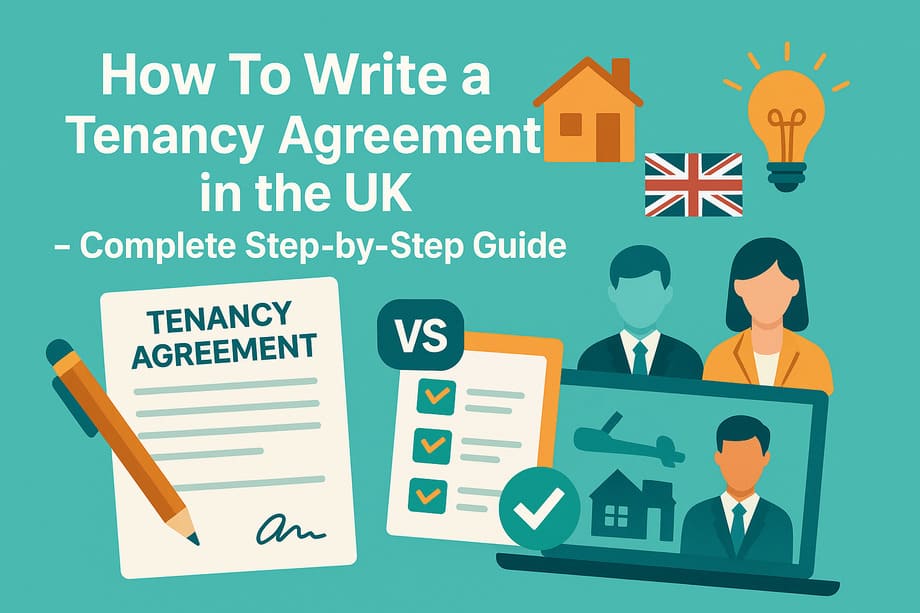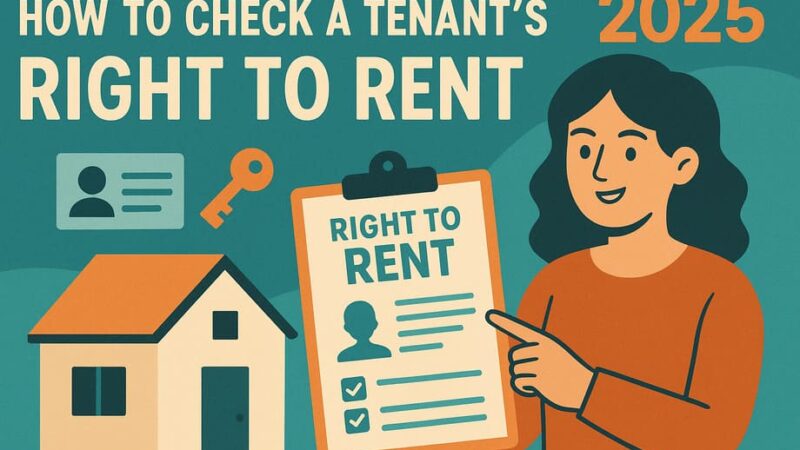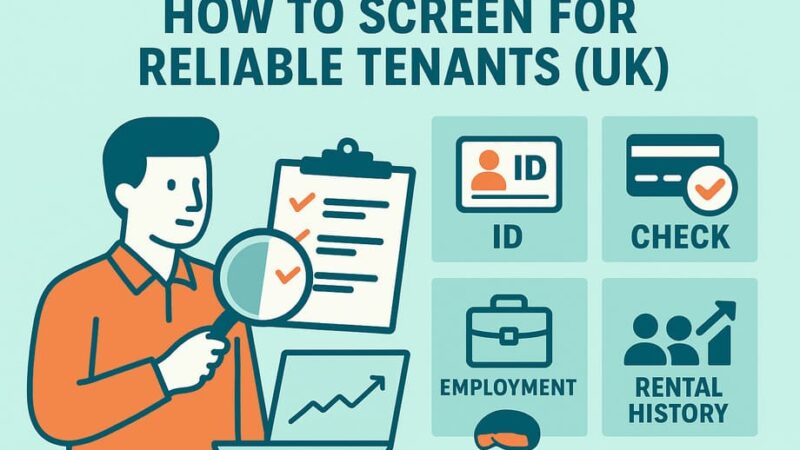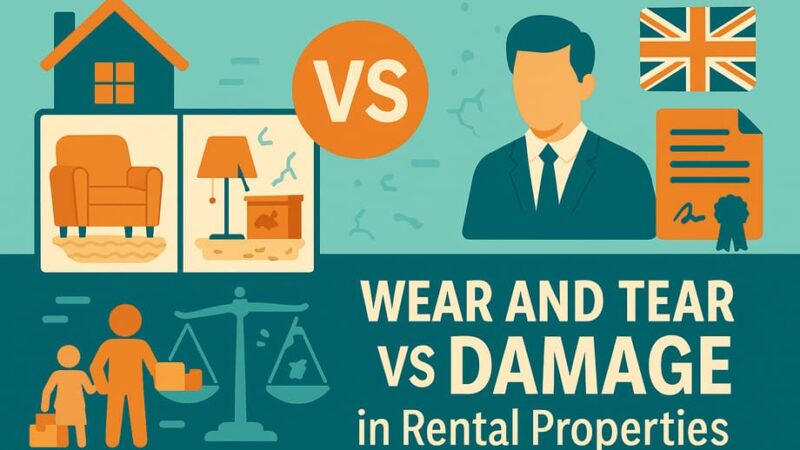How To Write a Tenancy Agreement in the UK – Complete Step-by-Step Guide

Creating a bulletproof tenancy agreement is crucial for protecting your property investment and establishing clear expectations with your tenants. With rental law constantly evolving and the Renters’ Rights Bill set to transform tenancies by 2026, getting your agreement right has never been more important.
This guide will walk you through everything you need to know to create a legally compliant, comprehensive tenancy agreement that protects your interests.
What is a Tenancy Agreement?
A tenancy agreement is a legally binding contract between you (the landlord) and your tenant. It sets out:
- The terms and conditions of the rental arrangement
- Rights and responsibilities of both parties
- How long the tenancy will last
- What happens if things go wrong
Why You Need One:
- Provides legal protection for both parties
- Sets clear expectations and rules
- Essential for eviction procedures
- Required by most insurance providers
- Helps prevent disputes and misunderstandings
Step 1: Choose Your Tenancy Type
Assured Shorthold Tenancy (AST)
Most Common Option:
- Default tenancy type in England for private landlords
- Offers good balance of rights for both parties
- Allows use of Section 21 “no-fault” evictions
- Typically lasts 6-12 months initially
When AST Applies:
- Private landlord letting to private tenant
- Landlord doesn’t live in the same property
- Rent between £250-£100,000 per year
- Tenant has exclusive possession
Other Tenancy Types
When AST May Not Apply:
- Company or business tenancies
- Rent exceeds £100,000 annually
- Holiday or temporary lettings
- Landlord lives in same building (sometimes)
Future Changes: The Renters’ Rights Bill will abolish ASTs in 2026, making all tenancies periodic from the start.
Step 2: Essential Information to Include
Property Details
Must Include:
- Full property address including postcode
- Description of what’s being let (whole house, flat, room)
- Whether furnished, part-furnished, or unfurnished
- Any parking spaces or garden areas included
- Which utilities/services are included
Landlord Information
Required Details:
- Full legal name(s) of landlord
- Contact address for notices
- Phone number and email
- Agent details (if using letting agent)
Tenant Information
Essential Details:
- Full legal names of all adult occupiers
- Current addresses before tenancy
- Contact numbers and email addresses
- Emergency contact information
- Maximum number of people allowed to live in property
Step 3: Key Terms and Conditions
Tenancy Period
- Clear start and end dates
- Usually 6-12 months initially
- Provides security for both parties
- Harder to end early without break clause
What to Specify:
- Exact start date and time
- End date of fixed term
- What happens when fixed term expires
- Whether it becomes periodic automatically
Rent Details
Must Include:
- Exact monthly rent amount
- Payment due date (e.g., 1st of each month)
- Payment method (bank transfer, standing order)
- Whether rent is payable in advance
- Late payment procedures and charges
- When and how rent can be increased
Example Clause: “Rent of £1,200 per month payable in advance on the 1st day of each month by bank transfer to [account details].”
Deposit Information
Legal Requirements:
- Maximum deposit amount (usually 1-5 weeks’ rent)
- Which deposit protection scheme will be used
- What deposit can be used for
- How and when it will be returned
Must Protect Within 30 Days:
- Register with approved scheme
- Provide prescribed information to tenant
- Failure prevents Section 21 notices
Step 4: Rights and Responsibilities
Landlord Obligations
Legal Requirements:
- Ensure property is safe and habitable
- Maintain structure and exterior
- Service gas, water, electricity, and heating systems
- Provide required safety certificates
- Protect tenant’s deposit
- Respect tenant’s quiet enjoyment
Tenant Responsibilities
Standard Obligations:
- Pay rent on time
- Keep property clean and in good condition
- Report repairs promptly
- Allow access for inspections and repairs
- Not cause nuisance to neighbors
- Not subletting without permission
Maintenance and Repairs
Landlord Responsibilities:
- Structure and exterior maintenance
- Heating and water systems
- Gas and electrical safety
- Emergency repairs
Tenant Responsibilities:
- Day-to-day maintenance
- Garden upkeep (if specified)
- Changing light bulbs and fuses
- Reporting damage or problems
Step 5: Important Clauses to Include
Rent Review Clause
If You Want to Increase Rent:
"The Landlord may increase the rent by giving not less than [X] months' written notice,
such increase to take effect on [anniversary date/rent due date]."
Break Clause (Optional)
Allows Early Termination:
- Specify when it can be used (e.g., after 6 months)
- Notice period required (usually 1-2 months)
- Conditions that must be met
- Remember: applies to both landlord and tenant
Property Use
Specify Clearly:
- Property for residential use only
- No business activities without permission
- Rules about guests and visitors
- Overnight stay limitations
Pets and Smoking
Common Restrictions:
- No pets without written permission
- No smoking anywhere on the property
- Consequences for breaching these rules
Step 6: Legal Requirements and Documentation
Documents You Must Provide
Before Tenancy Starts:
- How to Rent guide (latest version)
- Energy Performance Certificate
- Gas Safety Certificate (annual)
- Electrical Installation Condition Report (every 5 years)
- Deposit protection information
Right to Rent Checks
Legal Requirement:
- Check all adult tenants’ right to rent in UK
- Take copies of acceptable documents
- Keep records for at least 2 years
- Re-check if limited right to rent
Safety Requirements
Must Comply With:
- Smoke alarm installation and testing
- Carbon monoxide detector requirements
- Gas safety annual inspections
- Electrical safety standards
- Fire safety regulations (especially HMOs)
Step 7: Notice Periods and Termination
Ending the Tenancy
Landlord Options:
- Section 21 notice (no-fault) – 2 months’ notice
- Section 8 notice (fault-based) – various notice periods
- Mutual agreement to end early
- Break clause activation
Tenant Notice:
- Usually 1 month for periodic tenancy
- Must end on correct day (last day of period)
- Break clause procedures if applicable
Notice Serving Requirements
Important Rules:
- Must be in writing
- Use correct prescribed forms
- Serve to all named tenants
- Keep proof of service
- Allow correct notice periods
Step 8: Writing Your Agreement
Option 1: Use Professional Templates
Skip the hard work and grab our ready-made tenancy agreement template, which includes:
- All legal requirements
- Current law compliance
- Clear, enforceable clauses
- Professional formatting
- Regular updates
Option 2: Government Model Agreement
Free Government Template:
- Available on GOV.UK
- Designed for longer tenancies (2+ years)
- Includes rent review and break clauses
- Must be used without amendments
Option 3: Professional Legal Services
When to Get Legal Help:
- Complex property arrangements
- HMO or commercial elements
- Unusual tenant situations
- Adding bespoke clauses
- High-value properties
Step 9: Common Mistakes to Avoid
Unenforceable Clauses
Avoid Including:
- Professional cleaning requirements
- Excessive property rules
- Clauses removing landlord’s legal obligations
- Unfair penalty charges
- Restrictions on tenant’s statutory rights
Missing Information
Don’t Forget:
- Deposit protection details
- Right to rent documentation
- Contact information for all parties
- What happens at end of fixed term
- Emergency contact procedures
Outdated Terms
Regular Updates Needed:
- Law changes frequently
- Safety requirements evolve
- Deposit rules change
- New fees may be banned
Step 10: Before You Sign
Final Checklist
Verify Everything:
- All names and addresses correct
- Rent amounts and dates accurate
- All required documents referenced
- Contact details up to date
- Both parties understand all terms
Signing Process
Best Practices:
- Both parties sign before tenant moves in
- Sign all pages and initial changes
- Provide copy to tenant immediately
- Keep original safely stored
- Consider witnessed signatures
After Signing
Don’t Forget:
- Register deposit within 30 days
- Provide prescribed information
- Keep records of all documentation
- Set up rent collection system
- Plan first property inspection
Adapting for Different Property Types
Houses in Multiple Occupation (HMOs)
Additional Requirements:
- HMO licensing compliance
- Fire safety measures
- Room size standards
- Shared area rules
- Individual or joint tenancy decisions
Furnished Properties
Extra Considerations:
- Detailed inventory essential
- Furniture safety compliance
- Wear and tear expectations
- Replacement procedures
Student Properties
Special Considerations:
- Academic year alignment
- Guarantor requirements
- Multiple tenant arrangements
- Holiday period occupation
Future-Proofing Your Agreement
Preparing for Renters’ Rights Bill
Expected Changes by 2026:
- All tenancies become periodic
- No more fixed-term agreements
- Section 21 abolished
- Enhanced tenant rights
- New eviction procedures
What to Do Now:
- Create agreements you can adapt
- Build good tenant relationships
- Understand Section 8 grounds thoroughly
- Consider longer-term tenant retention strategies
Professional Help and Resources
When to Seek Professional Advice
Consider Professional Help For:
- First-time landlords
- Complex property situations
- Previous legal disputes
- Unusual tenant arrangements
- High-value investments
Quality Template Sources
Trusted Providers:
- Government model agreements
- Landlord associations (NRLA)
- Legal document specialists
- Professional property management companies
- Established letting software providers
Cost vs Value
Investment Perspective:
- Professional agreement: £50-£200
- Legal dispute costs: £1,000s
- Lost rent during disputes: £100s per month
- Proper agreement prevents problems
Key Takeaways
Essential Success Factors
Critical Elements:
- Use current, legally compliant templates
- Include all required information
- Be specific about terms and conditions
- Provide all mandatory documentation
- Keep detailed records
Golden Rules
Remember:
- Never hand over keys without signed agreement
- Both parties must understand all terms
- Keep agreements updated with law changes
- Seek professional help when unsure
- Prevention is cheaper than cure
Final Advice
Professional Approach:
- Treat tenancy agreements seriously
- Invest in quality documentation
- Build positive tenant relationships
- Stay informed about law changes
- Plan for the regulatory future
A well-crafted tenancy agreement is your foundation for successful property letting. Take time to get it right, use professional resources, and ensure full compliance with current law. This investment in proper documentation will save you time, money, and stress throughout your landlord journey.
Remember: The rental market is changing rapidly. Stay informed, keep your agreements current, and don’t hesitate to seek professional advice when needed. Your tenancy agreement isn’t just paperwork – it’s the blueprint for your entire landlord-tenant relationship.
Last Updated on October 23, 2025 by James Cartwright







